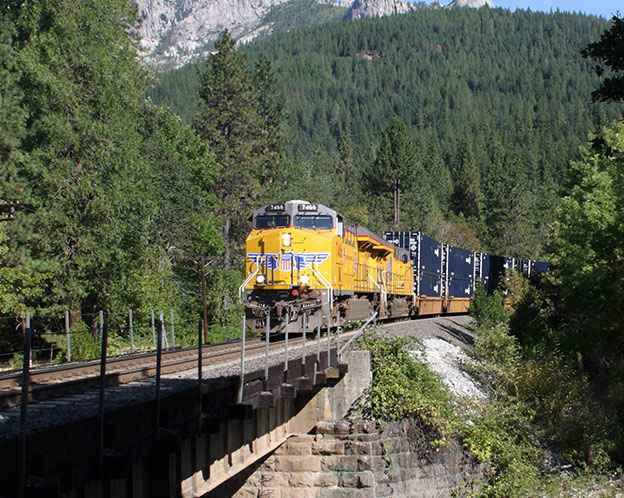Rail 101
Your guide to railroad basics.
Rail can offer a cost effective way to ship large quantities of goods, but often people don't understand how it works. Here are some basics.
What Can You Ship?
The simple answer is almost anything, from raw materials to finished goods and everything in between.
-

Raw Materials
Sand, plastic pellets, soda ash, flour, rock, fibers, minerals
-

Building Materials and Component Parts
Auto parts, lumber, pipe, metals, paper, rebar, metal coil, bricks
-

Fuel
Ethanol, biodiesel, diesel exhaust fluid (DEF), petroleum, LPG, coal
-

Food and Beverages
Packaged food, canned goods, frozen food, produce, seafood, cheese, chocolate, grain, feed products, corn syrup, beer, wine, tequila, orange juice
-

Finished Goods
Shoes, clothing, toys, furniture, appliances, electronics, automobiles, machinery, military vehicles, carpet, irrigation equipment, paper, solar panels
That's a very short summary of a very long list of possibilities. The list of what you can't ship by rail is very short: personal property, passengers, pets or other living things.
Where Can You Ship?
Between Class I Railroads and short line railroads, you can ship pretty much anywhere in North America.
Class I Railroads: The United States has five Class I Railroads — these are the companies that operate the major rail lines spanning the country. While each company owns its own network of tracks, they do interchange traffic with each other, which means you can ship coast to coast, even if it involves more than one railroad. These railroads also interchange traffic with railroads in Canada and Mexico, giving you access across the borders, too.
Short Line Railroads: Short line railroads tend to operate in more localized areas moving bulk and oversized carload shipments. Although they have "shorter lines" than Class I Railroads, they provide vital connections in areas where the major railways don't have tracks.
What If I Don't Have Access to Tracks?
A common misperception is that an origin and destination must have tracks at their doors to use rail. Fortunately, that's not the case. Thanks to intermodal shipping and transloading, products can move seamlessly between trucks and trains and back again. If an origin isn't rail served, trucks can pick up your products and they can be transferred to a train at a transload facility or intermodal ramp. Then, if the destination isn't rail served, they can be transferred back to trucks for final delivery.
Intermodal: Technically, intermodal shipping simply refers to moving freight by two or more modes of transportation. But when rail shippers talk about "intermodal," they usually mean shipments that travel in containers. With intermodal shipping, products are loaded into a container, which is then placed on a truck chassis. Once it reaches an intermodal ramp, the container is lifted off the chassis, then placed on a flat or well car to travel by train. The container is then transferred back to a truck for final delivery.
Transloading: Transloading is very similar to intermodal shipping in that products are transferred between trucks and trains. The difference is that, where products stay in the same container from origin to destination when shipped intermodally, with transloading, products are moved between containers. For instance, a forklift may transfer palletized goods from a truck to a larger rail car, or a crane may lift heavy products like steel beams off a rail car and place them on a flatbed truck.
Shippers leverage intermodal shipping and transloading as a means of accessing the economic advantages of shipping by rail. Doing so combines the flexibility of over-the-road trucking with the affordability of long-haul rail shipping, all without an investment in tracks.

What Are the Benefits of Rail?
Rail offers several advantages:
- Large, available cargo capacity
- Most efficient transportation option for long-haul moves
- Lower cost per ton mile
What benefits do these features offer shippers?
- Market Reach: The rail network stretches across the U.S., Canada, and Mexico, so you can ship to distant markets more affordably.
- Scalability: Rail can accommodate even your largest loads — and will be ready for more when your business grows.
- Reliability: Rail is a 24/7 operation, pushing forward when trucks can't.
- Sustainability: Railroads provide the most fuel efficient and environmentally responsible mode of ground freight transportation.
- Cost Savings: Rail is almost always a more affordable transportation solution than truck, especially for long-haul shipments.
Want to Learn More?
If you want to learn more about how rail works or how you can access the benefits of rail, get in touch! We'd be happy to answer any questions you have.
Connect With Us
